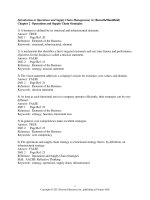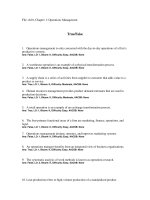IB minitest 8 Chapter 8 – Global Operations and Supply Chain Management
Bạn đang xem bản rút gọn của tài liệu. Xem và tải ngay bản đầy đủ của tài liệu tại đây (106.99 KB, 2 trang )
INTERNATIONAL BUSINESS
Minitest
Chapter 8 – Global Operations and Supply Chain Management
I. Choose the correct answers.
1. The most important reason for sourcing globally is:
A)
to obtain foreign products that are not available locally.
B)
the firm's worldwide operation and attitude.
C)
to obtain advanced technology from foreign sources.
D)
to obtain lower prices from foreign sources.
2. Which of the following arrangements can provide a firm with foreign products?
A)
Wholly owned subsidiary.
B)
Overseas venture.
C)
In-bond plant contractor.
D)
all of the above.
3. There is a strong relationship between global sourcing and:
A)
ownership of foreign sources.
B)
a firm's total profit.
C)
a firm's global success.
D)
none of the above.
4. International freight, insurance and packing can add as much as __________ to the
quoted price of an imported product.
A)
6 to 8 percent
B)
8 to 10 percent
C)
10 to 12 percent
D)
12 to 14 percent
5. To lower manufacturing costs, the principal goal of Japanese firms is to:
A)
eliminate inventories.
B)
reduce the process time.
C)
lower labor costs.
D)
reduce inventory costs.
6. __________ has become a global center for high-technology businesses in recent
years.
A)
China
B)
Indonesia
C)
Vietnam
D)
India
7. __________, the most comprehensive of standards applies to industries involved in the
design, development, manufacturing, installation and servicing of products and services:
A)
ISO 9001
B)
C)
D)
ANSI/AQC90
ISO 9000.
ISO 14000.
8. Manufacturing rationalization is the:
A)
concentration of production at one central location.
B)
division of production among a number of producing units.
C)
allocation of labor costs based on product quality.
D)
location of production facilities in countries that have the most favorable
export laws.
9. Generally, it is easier for international corporations to standardize the concepts of total
quality management and synchronous manufacturing in their overseas affiliates than it is
to standardize the actual manufacturing facilities. Environmental forces that contribute to
this include:
A)
legal forces.
B)
financial forces.
C)
political forces.
D)
all of the above.
10. Production methods that are between capital-intensive and labor-intensive methods
are called:
A)
mid-range technologies.
B)
appropriate technologies.
C)
intermediate technologies.
D)
none of the above.
II. Decide the statements whether are true or false.
1. The "over-the-wall" approach to product design is sequential in nature, and its initial
step is the product's designs are prepared by the designers.
2. The rate at which developing nations shift to more sophisticated processes is often
slower than for the initial emergence of these processes in a developed country.
quicker
activity-based costing
3. Firms increasingly are using indirect procurement systems to ensure that all the costs
associated with foreign sourcing are fully recognized when they make purchasing
decisions.
4. To avoid an increase in price because the home currency has lost value, an American
importer should require exporters to quote in their currency. dollar prices
5. Many U.S. manufacturers copied parts of the just-in-time system without realizing it is
a total system.









